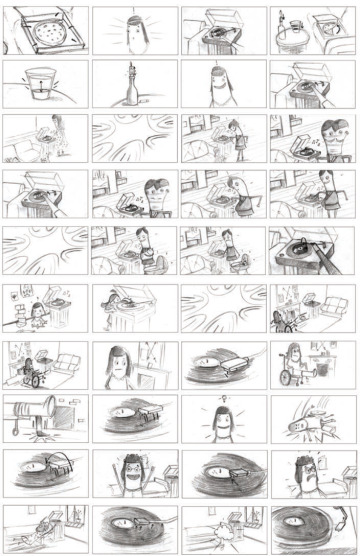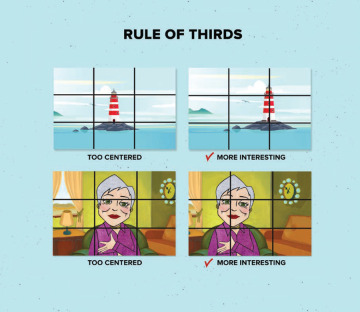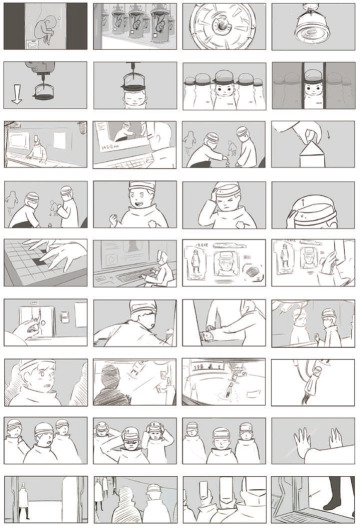Storyboarding Hints
Okay, now that you know the steps to set up the basic structure of your storyboards, what are the best methods for creating effective storyboards? Or in other words, what do you need to consider throughout the storyboard process to help bring the full scope of your story to life visually? It has a lot to do with putting on your director’s hat. You have to compose your “shots” as in a movie, not only for clarity (which is the most important thing) but also for maximum emotional impact. That means learning a thing or two about shot composition, framing, staging, and transitions. These are the details that you add frame by frame making each a perfect unit as they allow the complete story to unfold.
Shot Composition
Want to give your audience the feel of a majestic location—say, a mountain peak at sunset? A slow, panning extreme wide shot will evoke the mountain’s beauty and sheer size. What about the lone climber who finally reaches the summit of that mountain? How best to capture their joy? A close-up will best reveal the expression on their face (and tears in their eyes) with maximum intimacy. Your audience is hungry for information, and shot composition is all about revealing information to your audience. You can get as close to, or as far away from, a subject as you want (as director you have the power of X-ray vision, flight, and invisibility all at once), so take the initiative to bring your audience right up to the action.
But composing different sized shots isn’t only about providing information for your audience. It can also be used to withhold information for maximum effect. Take our mountain climber who has reached the peak. Let’s say we choose a medium close-up to give the impression that she has finally reached the peak. We show our climber weeping in triumph, jumping up and down in victory—she has defeated the great mountain. But then we pull back to a wide shot to reveal that in fact our climber has only hiked a tiny foothill at the base of the great mountain and is nowhere near the summit! With one quick change in shot size, our climber went from skilled and heroic climbing veteran to hopeless amateur. One size change to comedy gold.
Shot composition grants you the power to reveal information how you wish to your audience, so use your power with great care.
Framing
If sizing your shots is all about giving your audience the pertinent visual information they need, then framing is all about keeping that eye interested. Framing is the artistry of your shots, the “cinematography,” and, in a way, the poetry. Sure, you could just plop your subject in the middle of each frame, hell, you could plop a tornado in the middle of your storyboard frame and, yes, it will still be a tornado. But you want people to feel the wind, the chaos, and the movement of the tornado. Dynamic framing is one of the keys to enhancing the visual drama in your story.
The famed “rule of thirds” provides an easy-to-follow tool for keeping your framing dynamic. Simply break down your single frame into nine equally sized quadrants by dividing it both horizontally and vertically into thirds. Now, instead of placing your subject squat in the middle (which is considered a “static” location), place it in another box—the top, bottom, left, or right third of the frame. Try laying the focal point of your subject on one of the four “intersection points” where your quadrant lines meet.
Why do this, right? Seems random? Well, think of it as entertaining a child on Easter Sunday. If you want them to find an Easter egg, you wouldn’t just put it on the table in front of them. Since the child will naturally roam around for the Easter egg, they will likely be more excited by the egg once they find it under the park bench. It’s interactive. Same with the subject in your shot. The eye wants to roam and will feel more gratified if it goes searching to find your subject. Place your subject in the middle and there’s nowhere to go—it’s a boring game. Put your subject closer to the edges and there’s room to roam. Play the game by the rules (of thirds) and your shots will feel more pleasurable for the eye and will give your story a sense of excitement and suspense.
Staging
While thoughtful framing helps you compose shots around a subject in a way that keeps the viewer’s eye interested, staging is all about where you put that subject in space (and the other objects in the shot) in the scene in relation to the camera. Staging should create a visual and conceptual hierarchy for the objects and characters in your frame, placing them in a way that reinforces your overall story.
First thing to consider (as always) is clarity. You want your audience’s eye to clearly see what’s going on with your subject. So that means avoid crowding it with unnecessary visual information. Let’s say your project is about an animator who’s been up all night working on storyboards. Though their studio may have a big bookshelf or a stereo or heavily framed photos that are organic to the location, adding them to your shot means that your audience’s eye will roam to story dead zones—where visual information does not enhance your story. You want to stage only the visual elements that will enhance your story. In the case of our animator pulling an all-nighter, you may want to stage a waste bin filled to the brim with crumpled pages next to her desk, some empty cans, and/or an alarm clock that says 6:00 a.m. in big red letters to the side. Staging items around your subject should help to emphasize the idea that you’re trying to convey, while not detracting from the importance of your primary subject.
But staging has advantages beyond enhancing your subject. It can also provide depth to your shots. In the tangible sense, staging your subject gives a sense of physical depth to the environment. Let’s look at another example for this one. One character is handing car keys to another character. Placing the characters’ hands and keys large in the foreground and the car small in the background will immediately create depth and interest. This staging allows the audience’s eye to roam from the larger main subject to the background where it can discover the car. As mentioned earlier with the rule of thirds, discovery is a lot more pleasurable for the eye than instant gratification. Giving the eye some physical depth to explore for new information makes for a more interesting visual composition.
But there is another way that staging adds depth to your shots: in the story sense. By staging your subject along with important visual information, you offer your audience a deeper read of what’s happening in your story. In the case of the animator, the crumpled papers in the waste bin, of course, represent the animator’s trial and error, but a deeper analysis could interpret that the overflowed waste bin represents her indomitable spirit. You must earn this leap through consistent storytelling, but once your audience gets to interpreting visual information, you may be surprised at some of the connections they make. This is generally why people call a good story “deep.”




